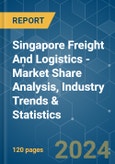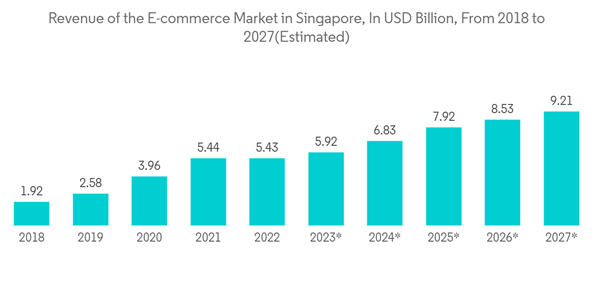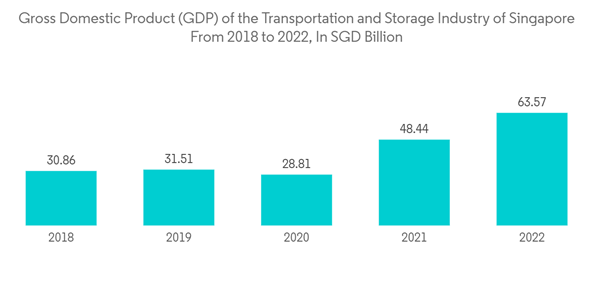Singapore's freight and logistics market size was estimated at USD 67.22 billion in 2024 and is anticipated to register a growth rate of 4.32% reaching a value of USD 92.18 billion by 2029. During the COVID-19 pandemic, the Maritime and Port Authority of Singapore (MPA) ensured minimum disruption to the shipping industry, as it is critical to supporting Singapore in overcoming the pandemic. The Port of Singapore remains open for cargo operations and marine services, including bunkering, ship including bunkering, ship supplies, and shipyard repairs, to ensure commerce by sea and global supply chains remain undisrupted.
The first initiative will strengthen Singapore's digital infrastructure, particularly digital connectivity, data analytics, payment systems, and new business innovation.
A key initiative will be developing 5G infrastructure, the backbone of the country's digital economy. About 50% of the country will have 5G coverage within two years, and there will be two nationwide 5G networks by 2025. The greater bandwidth from the networks will increase the capacity to handle large e-commerce orders.
Singapore is ramping up its cybersecurity capabilities to protect businesses and ensure that cross-border data flow is secure.
The country signed the world's first digital-only trade agreement through the Digital Economy partnership Agreement (DEPA) with New Zealand and Chile to strengthen this aspect. Through this agreement, Singapore aims to develop international frameworks to support businesses engaging in cross-border digital trade and e-commerce.
Singapore identified key underlying infrastructures that it believes will pave the way for the country to become a global and regional e-commerce hub. Its "five-pronged" strategy includes building out the local 5G networks, supply chain capabilities, and payment platforms.
Singapore has seamless transport connectivity. It has dense sea and road networks for multimodal transshipment, with a Seamless intermodal connectivity between one of the world's busiest seaports and airports. PSA has four container terminals, one multi-purpose terminal, and one vehicle transshipment terminal operational in the country. PSA also has a huge shipping line network of 200 shipping lines, connecting 123 countries with vessels, with a frequency of 60 per day.
Singapore will also continue to develop its supply chain capabilities. In this regard, Enterprise Singapore and other government agencies will work with the logistics sector to value-add to cold-chain management, retail, and pharmaceutical logistics. A data infrastructure foundation will be built up for sharing secure data across supply chains.
The Singapore government has already started transforming logistics as part of its USD 4.5 billion Industry Transformation Programme. The program's primary objective is to drive excellence in logistics operations and become leaders in innovation while also building a strong core of local logistics talent, making Singapore attractive to inward investment. This scheme is named the Logistics Industry Transformation Map (ITM), and it follows similar plans for Singapore's food and beverage and precision engineering sectors.
Airport Logistics Park of Singapore (ALPS) has the leading global third-party logistics companies (3PLs), like Expeditors, DB Schenker, and Nippon Express, with sizeable facilities.
This product will be delivered within 2 business days.
Key Highlights
- Singapore has strengthened its status as a global logistics hub amid the COVID-19 pandemic, riding on its competitive advantages such as the efficiency, reliability, and resilience of its network.
- As Singapore is a major transhipment hub and serves as a gateway to some of the key regions, any changes in the global shipping industry affect Singapore's logistics market, majorly in sea and air. Singapore is also significantly affected by the changes in the global manufacturing sector.
- Government agencies have worked to ensure that any disruptions in Singapore's supply chain network are quickly overcome by providing options in other parts of the network. Singapore has moved toward higher value-added logistics services such as contract logistics that provide customized and end-to-end solutions for companies.
- Leading international logistics firms, such as DHL, UPS, and DB Schenker, have made Singapore their regional headquarters, while multinational corporations, like GlaxoSmithKline and Unilever, have located their regional supply chain management teams.
Singapore Logistics Market Trends
Growing E-commerce in Singapore
Singapore continues to evolve as a major e-commerce market and is expected to grow at a compound annual growth rate of 16.2% from SGD 7.8bn (USD 5.9bn) in 2021 to SGD 14.2bn (USD 10.7bn) in 2025The first initiative will strengthen Singapore's digital infrastructure, particularly digital connectivity, data analytics, payment systems, and new business innovation.
A key initiative will be developing 5G infrastructure, the backbone of the country's digital economy. About 50% of the country will have 5G coverage within two years, and there will be two nationwide 5G networks by 2025. The greater bandwidth from the networks will increase the capacity to handle large e-commerce orders.
Singapore is ramping up its cybersecurity capabilities to protect businesses and ensure that cross-border data flow is secure.
The country signed the world's first digital-only trade agreement through the Digital Economy partnership Agreement (DEPA) with New Zealand and Chile to strengthen this aspect. Through this agreement, Singapore aims to develop international frameworks to support businesses engaging in cross-border digital trade and e-commerce.
Development of Logistics Infrastructure and Connectivity
The government of Singapore continues to invest in transport infrastructure to maintain the country's position as a world-class city and key transport mode between Asia and the world.Singapore identified key underlying infrastructures that it believes will pave the way for the country to become a global and regional e-commerce hub. Its "five-pronged" strategy includes building out the local 5G networks, supply chain capabilities, and payment platforms.
Singapore has seamless transport connectivity. It has dense sea and road networks for multimodal transshipment, with a Seamless intermodal connectivity between one of the world's busiest seaports and airports. PSA has four container terminals, one multi-purpose terminal, and one vehicle transshipment terminal operational in the country. PSA also has a huge shipping line network of 200 shipping lines, connecting 123 countries with vessels, with a frequency of 60 per day.
Singapore will also continue to develop its supply chain capabilities. In this regard, Enterprise Singapore and other government agencies will work with the logistics sector to value-add to cold-chain management, retail, and pharmaceutical logistics. A data infrastructure foundation will be built up for sharing secure data across supply chains.
The Singapore government has already started transforming logistics as part of its USD 4.5 billion Industry Transformation Programme. The program's primary objective is to drive excellence in logistics operations and become leaders in innovation while also building a strong core of local logistics talent, making Singapore attractive to inward investment. This scheme is named the Logistics Industry Transformation Map (ITM), and it follows similar plans for Singapore's food and beverage and precision engineering sectors.
Singapore Logistics Industry Overview
The market is fragmented in nature. Most manufacturing companies base their supply chain control towers and distribution centers in Singapore to orchestrate their regional and global supply chains. This scenario has attracted global logistics companies to mark their footprint in the Singaporean logistics industry. Changi Airport is home to four major express players, DHL Express, FedEx Express, TNT Express, and UPS.Airport Logistics Park of Singapore (ALPS) has the leading global third-party logistics companies (3PLs), like Expeditors, DB Schenker, and Nippon Express, with sizeable facilities.
Additional Benefits:
- The market estimate (ME) sheet in Excel format
- 3 months of analyst support
This product will be delivered within 2 business days.
Table of Contents
1 INTRODUCTION
4 MARKET DYNAMICS AND INSIGHTS
5 MARKET SEGMENTATION (Market Size By Value)
6 COMPETITIVE LANDSCAPE
8 APPENDIX
Methodology

LOADING...









